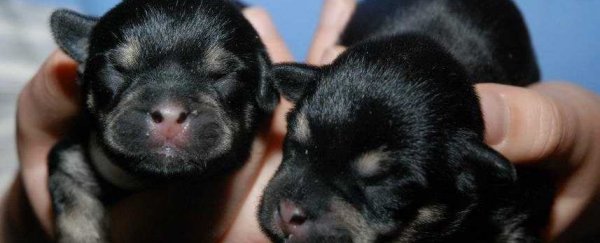If the success of the Sooam Biotech Research Foundation laboratory in South Korea is anything to go by, some people really love their dogs.
The lab, as Business Insider reports, is using the same technique that was used to clone Dolly the sheep back in 1996 to create perfect DNA replicas of people's pets.
For some people, apparently, US$100,000 is a small price to pay for a few more years with their best friend.
The process is known ash nuclear transfer and works by taking a few cells from your pet and then reprogramming them to stop growing.
The scientists then suck up the nucleus (the control centre of the cell that contains the DNA) of one of these dormant cells and injects it inside the egg of another dog that's been emptied of its nucleus.
The egg cell is then zapped with electricity which triggers it into forming a new cell that can divide and develop - essentially this process resets the cells into an embryo containing the DNA of the dog that is to be cloned.
This cell is then implanted into a surrogate dog and, if all goes well, within a few months she'll give birth to a clone of your beloved pet.
Of course, the animal won't be identical - think of it more like an identical twin rather than a sci-fi style clone.
"The dog will not be 100 percent the same - the spots on a Dalmatian clone will be different, for example - but for breeds without such characteristics it will be very hard to tell them apart," Sooam biologist Insung Hwang told The Guardian last year.
Since the lab first started in 2006, they've cloned more than 400 dogs, Nature reports, and now apparently are cloning around 15 puppies a month.
But there's been no shortage of controversy. As Erin Brodwin writes for Business Insider:
"Eight years after winning international acclaim for cloning the world's first dog in 2005, Sooam founder and veterinarian by training Woo Suk Hwang was publically disgraced for falsifying research on human embryo cloning. Hwang (no relation to Insung Hwang) was expelled from Seoul National University, where he did the research, and is still facing criminal charges."
Still, for some people, the facility simply helps ease the loss of a favourite pet. In 2011, US businessman Peter Onruang's two best friends, Wolfie and Bubble, sadly passed away. But in preparation for the day he'd worked with the Sooam lab to find a way to keep their memory, almost literally, alive.
After storing the dogs' dead bodies in wet towels in the fridge, he had five days to take them to the lab to have their cells extracted and then cloned.
Three years later, he brought home their clones - Wolfie Bear and Wolfie Girl (pictured above as puppies) and Bubble Face and Bubble Rubble.
On the Facebook page he's now started on pet cloning, he wrote: "Am I Happy? More than I could ever possibly imagine after getting my heart broken from Wolfie and Bubbles death. All those that said I would be disappointed were all wrong."
Read more about what it feels like to have your dogs cloned over at Business Insider (and find out about the plan to clone a mammoth next).
And just let it sink in for a second that we now live in a world where we can clone our pet dogs.
Source: Business Insider, The Guardian
